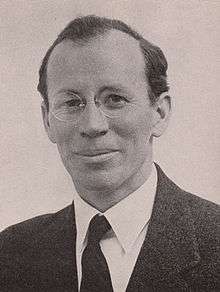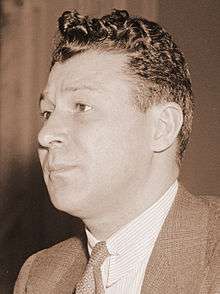Ware Group

The Ware group was a covert organization of Communist Party USA operatives within the United States government in the 1930s, run first by Harold Ware (1889–1935) and then by Whittaker Chambers (1901–1961) after Ware's accidental death on August 13, 1935.[1]
History
Background

Harold Ware founded this group under the auspices of J. Peters by Summer 1933. Ware was a Communist Party (CP) official working for the federal government in Washington, D.C..[2]
The first known meeting of the Ware Group occurred in late 1933 with eight members: John Abt, Henry Collins, Alger Hiss, Victor Perlo, Lee Pressman, Nathaniel Weyl, and Nathan Witt..[2]
Initially, Peters instructed that members make "exceptional money sacrifices" to the Party, study Marxist theory and Party doctrine, observe "strictest secrecy," and to obtain "any government documents" available to them. (Known members laters claimed that theirs was merely a "Marxist study group.)[2]
Known active years

By 1934, the group had grown to some 75 members, divided into cells. Members initially joined Marxist study groups and then into activities on behalf of the Party. They shared a belief that Marxist ideologies were the correct way to approach the problems of the ongoing Great Depression. Whittaker Chambers also stated that Ware could have been acting "pursuant to orders from the Central Committee of the Communist Party of the United States".[3]
The Ware group started among young lawyers and economists hired by the Agricultural Adjustment Administration (AAA). This New Deal agency reported to the Secretary of Agriculture but was operated independently of Department of Agriculture bureaucracy. All the members of the Ware Group were dues paying members of the Communist Party. J. Peters considered the Ware Group one of his major sources of income.[4] Nathaniel Weyl felt that members of the Ware Group were acquiring "the training in the complex business of running a state that would be in high demand and short supply when the United States chose Socialism", that "in a Communist regime they would be poised to move to the head of the table."[2][3]
Ware died of injuries sustained in an automobile accident near Harrisburg, Pennsylvania, in August 1935. J. Peters, who had introduced Whittaker Chambers to Harold Ware the year before, placed Chambers in charge of the Ware Group.[2][3]
Members of the group joined other "apparatuses" under Chambers.[3]
The group may have folded as such upon Chambers' defection from the Soviet underground in 1938. Some members seemed to have joined other groups, as attested by Elizabeth Bentley, including Victor Perlo and George Silverman.[2][3]
Hiss Case
.jpg)
On July 31, 1948. Bentley testified before the House Un-American Activities Committee (HUAC) regarding communist spy rings of which she knew. She named Chambers as someone who might corroborate. On August 3, 1948, Chambers testified under subpoena before HUAC about the existence of what he called the "Ware Group".[2][3]
During August 1948, the only remaining member who continued to face serious investigation was Alger Hiss, convicted in January 1950 on two counts of perjury.
Later corroboration

In 1950, Lee Pressman testified to Congress and confirmed his membership in the Ware Group.[5] Nathanial Weyl also confirmed his membership in the group, and said Hiss had been a fellow member.[6][7] In 1993, John Abt wrote in his memoirs that the Ware Group was a Communist Party unit and that he had been a member.[8] In 1994, Hope Hale Davis, a former Communist, also acknowledged that the Ware Group was a CPUSA unit, and she knew most of the people Chambers had named as fellow Communists and unit members.[9]
Notable members
Alleged members of the Ware Group included:
Harry Dexter White, then Director of the Division of Monetary Research in the United States Department of the Treasury, was also allegedly affiliated with the group.[2][3]
See also
References
- ↑ Gall, Gilbert J. "A Note on Lee Pressman and the FBI." Labor History. 32:4 (Autumn 1991).
- 1 2 3 4 5 6 7 8 Sakmyster, Thomas L. (2011). Red Conspirator: J. Peters and the American Communist Underground. University of Illinois Press. pp. 75–92, 94–97, 104, 119, 131, 138, 146, 175.
- 1 2 3 4 5 6 7 Chambers, Whittaker (1952). Witness. New York: Random House. pp. White on 29, 40, 67–68, 69, 70, 334, 370 383–384, 386, 405, 414–416, 419–421, 423, 426, 427, 429–432, 442, 470, 492, 500, 510–512, 544, 554, 600–; handover from Ware to Chambers on 31, 204, 332–348, 350, 352, 361, 370, 377, 378, 467, 542, 543, 552, 553, 624, 685, 686.
- ↑ Alger Hiss: Why He Chose Treason. Christina Shelton. Simon and Schuster. 2012.
- ↑ Hearings Regarding Communism in the United States Government — Part 2, pg. 2845.
- ↑ "Another Witness". TIME. March 3, 1952. Retrieved 2014-09-02.
- ↑ Hewitt, Alan (January 9, 1953). "I Was in a Communist Unit with Hiss". U.S. News and World Report. Retrieved 2014-09-02.
- ↑ Abt, John (1993). Advocate and Activist: Memoirs of an American Communist Lawyer. Champaign, IL: University of Illinois Press. ISBN 978-0-2520-2030-8.
- ↑ Davis, Hope Hale (1994). Great Day Coming. Hanover NH: Steerforth Press. ISBN 978-1-8836-4217-4.
Sources
- Chambers, Whittaker (1952). Witness. New York: Random House. pp. White on 29, 40, 67–68, 69, 70, 334, 370 383–384, 386, 405, 414–416, 419–421, 423, 426, 427, 429–432, 442, 470, 492, 500, 510–512, 544, 554, 600–; handover from Ware to Chambers on 31, 204, 332–348, 350, 352, 361, 370, 377, 378, 467, 542, 543, 552, 553, 624, 685, 686.
- Davis, Hope Hale (1994). Great Day Coming. Hanover NH: Steerforth Press. ISBN 978-1-8836-4217-4.
- Sakmyster, Thomas L. (2011). Red Conspirator: J. Peters and the American Communist Underground. University of Illinois Press. pp. 75–92, 94–97, 104, 119, 131, 138, 146, 175.